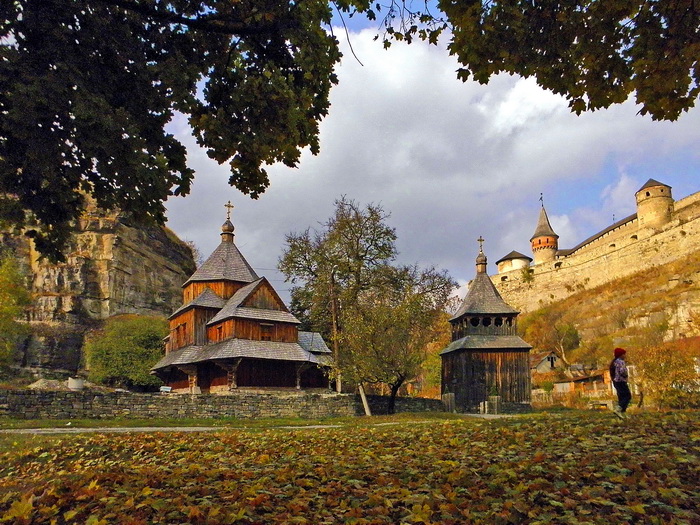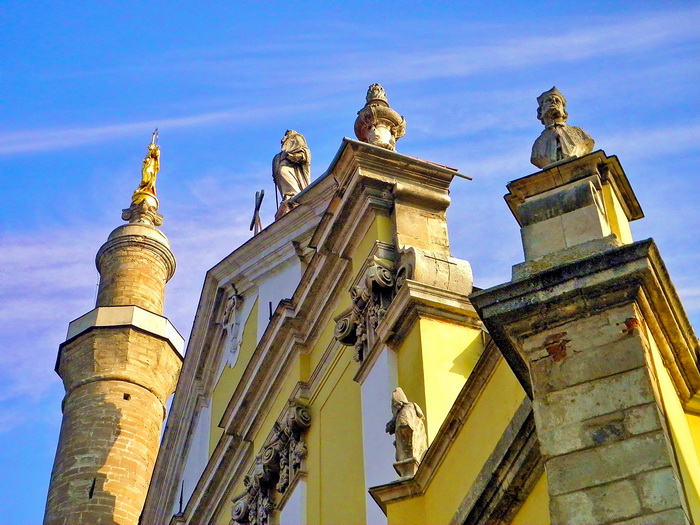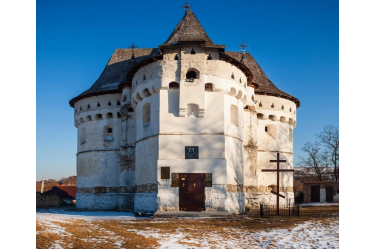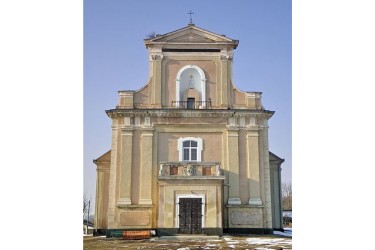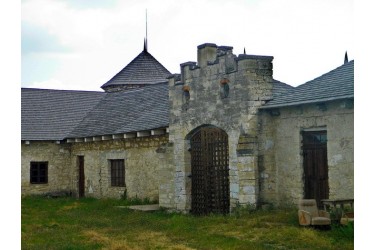In the north-western corner of the Polish Market Square stands the complex of the Cathedral Church of Peter and Paul – a unique church that has no equal in Ukraine. Its uniqueness is a combination of what seems impossible to combine: the Catholic Church, the Turkish (Muslim minaret) and the Madonna on it. In addition to the church, the complex includes a defensive bell tower and a triumphal arch.

It is believed that on the site of the cathedral there was a wooden church, which was built around 1370 by the Lithuanian princes Koriatovych. Five years later, at the request of the Polish king, the Pope Gregory XI established a diocese in Kamianets and the church became a cathedral. The first bishop is believed to have been the Dominican William. The construction of the stone church is associated with the Bishop Jakub Buchatski (1502-1517), who was a pious and a wealthy man, who also allocated funds for the fortification of Kamianets Castle.

Initially, the church was done in the Romanesque style, simple in form and had three naves. At that time, the altar was oriented to the west and was located where the entrance to the temple is now. By the middle of the 17th century, the church was formed as a three-nave, with a long presbytery, several Renaissance chapels and a high vestibule building, the western pediment of which was solved in the forms of Mannerism.

After the invasion of Kamianets by the Turks in 1672, the cathedral was turned into a major Muslim mosque. A 36.5-meter-high minaret was added to the western side. It was based on the chapel of the 16th century, in the form of a cube, which the Turks laid with stones, and on top set a round 20-meter tower with 145 spiral stone stairs in the middle and a balcony on the top of which five times a day the muezzin called for prayer. All the ornaments and belongings that were in the church were destroyed by the Turks. They also took out of town the bones of Christians buried in the cemetery near the cathedral.

After Podillia returned to the Kingdom of Poland in 1699, Bishop Jan Gninskyi reconsecrated the mosque back to the church. This event is evidenced by 2 memorial plaques on pylons on both sides of the central nave. In the middle of the 18th century, Bishop Mykola Dembovskyi (1740-1757) with the participation of the architect Jan de Witte carried out a major overhaul, which gave it baroque features. The restoration of the minaret and the installation of a 3.5 m high copper statue of the Mother of God on it is also the merit of Mykola Dembovskyi. The figure was made in Gdansk and installed on May 10, 1756 with the bells ringing and gunfire in the castle. The Mother of God stands on the Earth and the Crescent and blesses the city and the region. Around her head she has a halo of 12 stars.

In the 18-19th centuries the church was reconstructed in the Baroque and Pseudo-Gothic style. During the renovation of 1853-1862, the artist D. Sampini, with the participation of the Lviv artist M. Iablonskyi, made tempera frescoes on the walls of the southern chapel. At the same time, stained glass windows made of bohemian glass, a floor made of Terebovlia sandstone and Carrara marble appeared, and a new 20-register organ of the Viennese master Hesse was installed.

Today the church is a three-nave basilica with a late Gothic faceted presbytery with buttresses. There are three crypts under the southern nave and the northern chapels. The main nave, which is separated from the side pillars by pylons, widens slightly to the east, due to which the side naves narrow in the eastern direction. The naves are covered with box vaults with ribbed moldings, the northern chapel of The Holy Communion (formerly of Saints Peter and Paul) is a bath with a lantern.

The church has four altars – in the naves and in the southern chapel of the Immaculate Conception.

The most interesting thing in the church is in the chapel of the Immaculate Conception of the Blessed Virgin. This is the tombstone of Laura Przezdetska done by the sculptor Viktor Brodskyi. It was originally installed on the grave of Laura Przezdetska in the Church of the Assumption of the Blessed Virgin Mary in Chornyi; Laura fell from her horse at the age of 21 and died.

In 1938 the tombstone was moved to the Kamianets Cathedral. The sculptural composition consists of a bed on which lies a girl looking like Laura. At the foot of the monument is an open book; to the left of the bed stands a cupid, watching a dream of a virgin. To the left and right of the bed on the ledge are busts of Laura’s parents – Sofia and Karl Przezdetski. The tombstone bears the inscription: “Virgin Laura. Faded away in the prime of life. Her beautiful face is the best in the world.”

Chapel of the Immaculate Conception of the Blessed Virgin:

Statue of the Blessed Virgin Mary of Lourdes:

The Main altar:

The Altar of the Heart of Jesus:

Chapel of the Blessed Sacrament with altar:

Saint Anthony:

Ambo:

The architecture of the church demonstrates the fusion of the Gothic (presbytery, narthex), Renaissance (Holy Communion Chapel) and Baroque (western facade, side naves) styles. The eastern face of the presbytery has an interesting solution in the form of an arch resting on buttresses, forming a niche.

The western facade, designed in the late Baroque style, with pilasters of composite order and a massive entablature, plays the most active compositional role.

The main entrance is accentuated by a high arched window with a baroque framing, a relief with a coat of arms and a commemorative inscription.

On the western pediment of the church there are stone statues of the Peter and Paul apostles and decorative vases, on the buttresses of the southern chapel of the Immaculate Conception – stone busts of bishops, which were removed from the main facade of the Catholic seminary.

In 1851, a side entrance to the south side of the cathedral was added – a narthex in the English Gothic style.


The bell tower, which dates back to the 16th century, was originally four-tiered and had a defensive purpose. This is evidenced by: two lower tiers with blank walls over 3.5 m thick, independent entrances to the 1st and 2nd tiers and internal stairs between the 2nd and 3rd tiers. The third tier was intended for bells, the 4th was defensive. In the 17th century, the height of the belfry without a roof reached about 30 m. The roof was tent, about 15 m high, with small spiers on the horns and dormers on four sides. The facades were divided by a perimeter horizontal group, below which the walls were deprived of openings, and above there were four large arched windows in the 3rd tier of bells and a number of loopholes in the 4th tier. In the middle of the 18th century, during the reconstruction of the church, the bell tower was rebuilt, probably by Jan de Witte: the 3rd and 4th tiers acquired a late Baroque decoration, the 5th tier was added, and the loopholes of the 4th tier were liquidated. In the 19th century the bell tower was repaired. Since then, there is a low tent roof, which has survived to this day.

The entrance to the backyard of the church is through the gate in the form of a triumphal arch in the late Baroque style. The gate was built in 1781, in honor of the arrival of Polish King Stanislav August to the city.

The arch is decorated with a sculptural group in the form of four angels and the central figure of St. John of Nepomuk. On the frieze on the east side there is a Latin inscription: “King Stanislaus Augustus passed here on November 11, 1781.”


Але він зазвичай зачинений:From the west (Kuznechna Street) there is another entrance to the cathedral backyard with an arch decorated with a sculpture of an angel. But it is usually closed:


View from the church backyard on the Polish Filvarki:

In 2007, a monument to Pope John Paul II was unveiled in the church backyard:

In the backyard there is a memorial sign to “Hector of Kamianets-Podilskyi” – Michal-Jerzy Volodyiovskyi, the prototype of the hero of Henrykh Sienkiewicz’s novel “Mr. Volodyiovskyi”, who died in 1672 during the defense of Kamianets-Podilskyi from the Turkish invasion.

The figure of Jesus the Sorrowful near the side facade of the church:


Tombstones in the courtyard in front of the church facade:

Sculptures near the southern facade:

Outbuildings in the north of the courtyard:

Next to the cathedral is a two-story palace of a Catholic bishop (16-19th centuries). Originally it was one-story, on a high plinth, with a four-pitched roof. At the end of the 17th century, it was damaged and in the early 18th century – restored. In the second half of the 19th century, were added 2 floors to the eastern part of it. The monument is one of the few palace-type medieval houses preserved in Ukraine. In the 17-18th centuries, the house was inhabited by bishops of Podillia, who periodically set aside separate rooms for Polish primary schools (classes). In 1793 the house was confiscated by the governor. From 1797 to 1831, the county five-grade school, subordinated to Vilnius University, was located here. Due to the Polish uprising of 1830-1831 it was closed. In the 30 – 60’s of the 19th century, the house belonged to the Kamianets Boy’s Gymnasium (classrooms were used, principals lived in the house). From 1869 to 1918 the building housed the city’s two-grade school. Today, it still belongs to the Polish bishop.

The former Catholic seminary faces the cathedral with its northern facade. The house was built in 1782 on the site of earlier buildings. The seminary was located here for a short time – until 1793. Later the house was adapted for provincial institutions. Thus, on the ground floor of the church was a provincial printing house. The architect’s department and the land commission were located on the west side of the Frantsiskanska Street. On the second floor from the east and north was the provincial board headed by the vice-governor. A gift from Catherine II – a mirror plate – was installed in the meeting room of the provincial board. It was a large bronze box (64 cm high, 54 cm long and 38.5 cm wide) of very interesting work, designed to store decrees. The third floor was added in the second half of the 19th century – over the north-western part, and in the 1950s – over the eastern part of the house.

To sum up, here are a few pictures:





